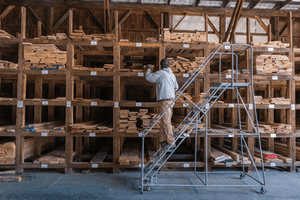Multifamily and affordable housing developers continue to feel the pain of the global supply chain crisis, with no immediate relief expected in the near future.

Developers estimate that supply chain issues have caused construction delays up to six months and cost increases as high as 40% over the past year.
Joseph DiSalvo, executive vice president of Michaels Construction, says his firm, which does both rehab and new construction projects, saw construction costs increase by approximately 8% last year, with fourth quarter numbers still being adjusted.
“There was an increase in construction materials across the board of approximately 18% to 20%,” he says. “These increases have been driven by the commodities markets, transportation cost, and the increased demand.”
Brooks estimates costs have increased 40% in the past 12 months, and he’s seeing delays ranging from 30 days to six months.
Lumber’s roller-coaster ride throughout the pandemic has taken a toll on multifamily construction.
“Lumber material pricing continues to be extremely volatile (for several reasons), but its overall impact to the construction budget is only 2% to 3% of the total,” say Cityview CEO Sean Burton and vice president of development Adam Perry. “When certain material inputs experience volatility, we try to account for that fluctuation in our rigorous underwriting process. We also try to hold sufficient contingencies for such unforeseen costs that we can use later in construction for any building or design enhancements to the extent not used or hold as cost savings.”
Developers say some of the most challenging products and materials to source today are appliances, cabinets, vinyl-plank flooring, windows, roofing and siding products, concrete, HVAC equipment, and switchgear equipment.
“The pandemic-induced supply chain issues are creating disruption that we expect will resolve itself in the coming years,” add the leaders from Cityview, which focuses on developing, acquiring, and operating value-add multifamily and mixed-use in the West. “However, until these current trends stabilize, developers will need to continue to be vigilant in their materials tracking and ensure materials are ordered with sufficient time to allow for foreseeable delays. Staying educated and up to date on real-time movement in the market is critical.”
Supply Chain Solutions
To overcome these issues, developers have had to start the procurement processes earlier, standardize products across regions, and shift to new approaches.
“One thing [Alliance Residential Co. has done] is the addition of my role last year. I work to form relationships and partnerships with suppliers at the field and senior levels, so when there are issues, we can go straight to decisionmakers and the individuals who can affect the supply chain,” says Brooks. “Working directly with the manufacturer or the source of the product in some trades simplifies communication and streamlines the entire process. In other trades, working with distributors simplifies the supply chain.”
Alliance Residential Co. also has shifted to standardization across its regions for products like appliances to maximize its national scale and purchasing processes to take some pressure off the supply chain.
“Usually, it is easier for a vendor to supply large quantities of a few items versus smaller quantities of a lot of items,” he says. “We communicate a general forecast of our needs to our national suppliers monthly so they can plan production and logistics well in advance of ship dates. In addition, our team has successfully re-sequenced projects based on what supplies are available.”
DiSalvo has seen the benefits of being part of a vertically integrated company, The Michaels Organization, one of the largest affordable housing owners and developers in the nation. Its Urban Practice architecture firm designs most of the projects for The Michaels Organization.
“We have all had to be flexible in accepting alternate and substitute products when necessary based on the availability and lead time issues,” he says. “We also have worked with our lenders and investors on procuring materials early and negotiating to have ‘stored materials.’”
Cityview leaders are looking at solutions to better control rising costs, with the firm and its subcontractor partners anticipating several rounds of price increases for a broad range of materials this year.
“To mitigate these expected increases, we frequently make deposits and place orders early (in many cases prior to executing agreements with our general contractor) with design-build subcontractors during the architectural design phase,” they say. “This allows us to control costs and mitigate schedule disruptions due to supply chain issues and long lead time deliveries.”
Additional Pressing Challenges
DiSalvo says cost escalation and inflation are two issues keeping him up at night.
“We are involved in many of our projects 12 to 18 months before they start, and it is very challenging to provide budget pricing at the conceptual phase and have it hold up throughout the pre-construction process,” he says. “Labor is also something that has me worried in the short term. There seems to be shortages in many trades, and there is no shortage of new construction projects starting in many of the markets in which we operate.”
Brooks agrees, saying “construction is not immune from the ‘Great Resignation,’ and there is not currently a solid infrastructure to backfill these positions.”
Burton and Perry add that climate change has started to impact some materials, such as lumber, and manufacturing plants due to an array of natural disasters.
“We have incorporated a climate risk assessment into our underwriting process using our acquisitions climate risk assessment tool that assesses a potential investment’s climate risk across 20 categories related to physical, transition, energy management, and health and safety,” the Cityview leaders say. “From this assessment, for investments we pursue, we explore a variety of mitigation measures that could include altering the building design, utilizing certain building materials, or designing landscaping in a particular manner, to name a few.”
Source: Multifamily Executive















 Accessibility
Accessibility